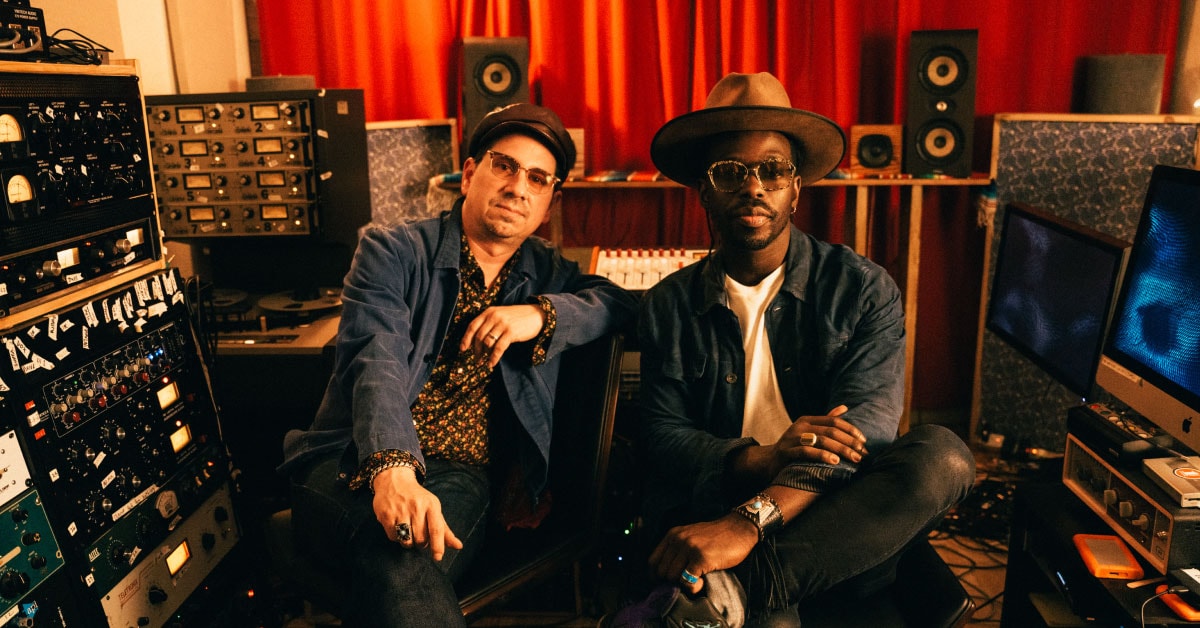When Adrian Quesada and Eric Burton first started working together in Austin, Texas, their intention was for it to be simply a studio project. Guitarist and producer Quesada—a long-time force on the Austin music scene and Grammy Award winner for Grupo Fantasma's 2011 release, El Existential—first teamed up with singer-songwriter Burton to record studio vocals in 2017. Burton—an L.A. native who grew up singing in church, studying musical theater and busking in Santa Monica—brought his soulful and dynamic performance style to Austin where he immediately starting making waves. The combination worked so well, that it took little time for the partnership to go from the studio to the stage, then from a 2019 performance at SXSW that drew serious acclaims to achieving six Grammy nominations in three short years. We had the chance to speak with them at the Austin studio they call home, Electric Deluxe Recorders, about how they got together, how they work together and some of their favorite gear.
You come from very different musical backgrounds. What inspires you about working together?
Adrian Quesada: When I first started this project with Eric, as soon as I heard his voice, it was like the Frankenstein scene where the monster gets electrified and everything just came to life. I can count on that. He’s just going to inject life into things, and it inspires me. In the studio, and in a live setting, I just perform better knowing that he’s out there.
Eric Burton: He's probably giving me a lot of credit. I note the fact that he’s opened up for the likes of Prince and collaborated with all kinds of people. We have an interesting way of inspiring each other. I bring a certain thing to the table that moves the people around me. I think what connects us—the thru line—is our styles. Our styles go so well together that we don’t have to spend too much time in each other’s lane.
What is your general process for creating a song together? For example, how did your song “Confines” come to be?
Burton: Most of the music on the album started with Adrian making the instrumental to then send to me. I eventually chose some, and we ended up having five of his instrumentals and five songs that I brought to the table.
Quesada: “Confines” was an instrumental that is 12/8 or 6/8 depending on how your brain does math, and it was funny because I didn’t think it was one that Eric would gravitate toward because it’s a different rhythm—and he just came in and killed it. He had this—what’s the concept?
Burton: “Row, row, row your boat?”
Quesada: Yeah, he said, “You know, ‘row, row, row your boat?”’ I’m like, “Uh, yeah.” He says, “All right—just hit record.” So, it was one of those that, you know, was there at the right place at the right time.
Can you shed some light on that lyrical concept?
Burton: At the time I wrote "Confines," I was trying to reinvigorate myself while pursuing a career, and it’s just kind of a reminder to keep in the middle, right? To keep “merrily, merrily on the scene.” It’s not too high and not too low, but just in the middle, and observing and continuing that way. You feel that?
Quesada: I remember that was one of those concepts—like sometimes Eric's concepts are like, “Man, that’s some amazingly lofty stuff.” I’m just a little bit more of a pragmatic person and Eric’s touching the sky, so to speak. But this is one where I really felt that concept.
Can you tell us a little about the space here at Electric Deluxe Recorders?
Quesada: Electric Deluxe Recorders in Austin, Texas, is the home base of Black Pumas. It is a recording studio, but primarily I like to think of it more as just a creative space. Creative energy is the thing that inspires me most about a studio—where you can just sit down and start making music and not have to wait for four hours. Everything’s plugged in and ready to go—like you come in, turn that on and we’re rolling. That’s the impetus behind a lot of the design and the layout.
Speaking of the energy of the studio, can you share the story about how the vibe here contributed to the name of the band?
Quesada: The name Black Pumas came toward the end of 2017. We were texting a bunch of different names, and I just went on this jungle cat tangent because of the jaguar logo in my studio. I was Googling stuff and just sending scientific names of cats to Eric. It was just this long text thread until we hit Black Pumas. It was definitely an extension of the studio, because the project originally was a studio project. We didn’t have plans to play live as a band at first.
Burton: I thought, "What is with this guy and cats?" It was like, "All right, Black Pumas kind of sounds cool."
When you are working in the studio, is there a moment where you just know you’ve created something special?
Quesada: I don’t think there's an exact answer to that. There are times in the studio when you know it, and you think, "That’s sick!" There are also times when you have to take it home and listen on your headphones, out of the studio element—maybe on a plane, in a car or whatever—and then you feel it. I don’t know that there’s a specific moment in the studio, but there are moments where you feel it—you just know it.
You are both accomplished guitarists with very different styles. Can you share a little about your backgrounds with the instrument?
Quesada: I started to play guitar and honestly always tried to find my own lane with it. When all my friends were doing the screaming solos on the guitar and everything, I was always digging into things like, "How do you make it like this rhythmic instrument?" And, you know, I’m still on that path to this day. My main thing with the instrument has been learning—and this is something you can probably hear on some of the guitar solos on the album—I’m really trying to play like he’s singing, rather than showing off how fast I can play or how many scales I know. The stuff that’s just classic to me is when people are singing on the guitar.
Burton: Mm, that’s dope. For me, the guitar was the first instrument that I chose to write songs on. I started in a very unorthodox way—less academic, more free-spirited. I do a lot with guitar—it’s very rhythmic—I’m playing bass lines. I’m doing little intricacies with single notes, and it’s all together a bit of a vibe. There’s a small yet very epic palette for what I’m doing, even in the most simplistic riffs or chord progressions. Our song “Colors” was one of the first songs that I’ve ever written. Just learning how to play guitar, I might have taken something like three or four strings on a parlor guitar, and I came up with that song, just one note after the next, like “What sounds good next? Let’s just take it a step at a time." I think that when I start writing a song, I know what I want to say. I can feel it, but I might not always know how I would make that tangible. The guitar is just a super-immediate instrument. Whatever you’re feeling—especially an acoustic or a hollowbody guitar, you feel the resonance right away.
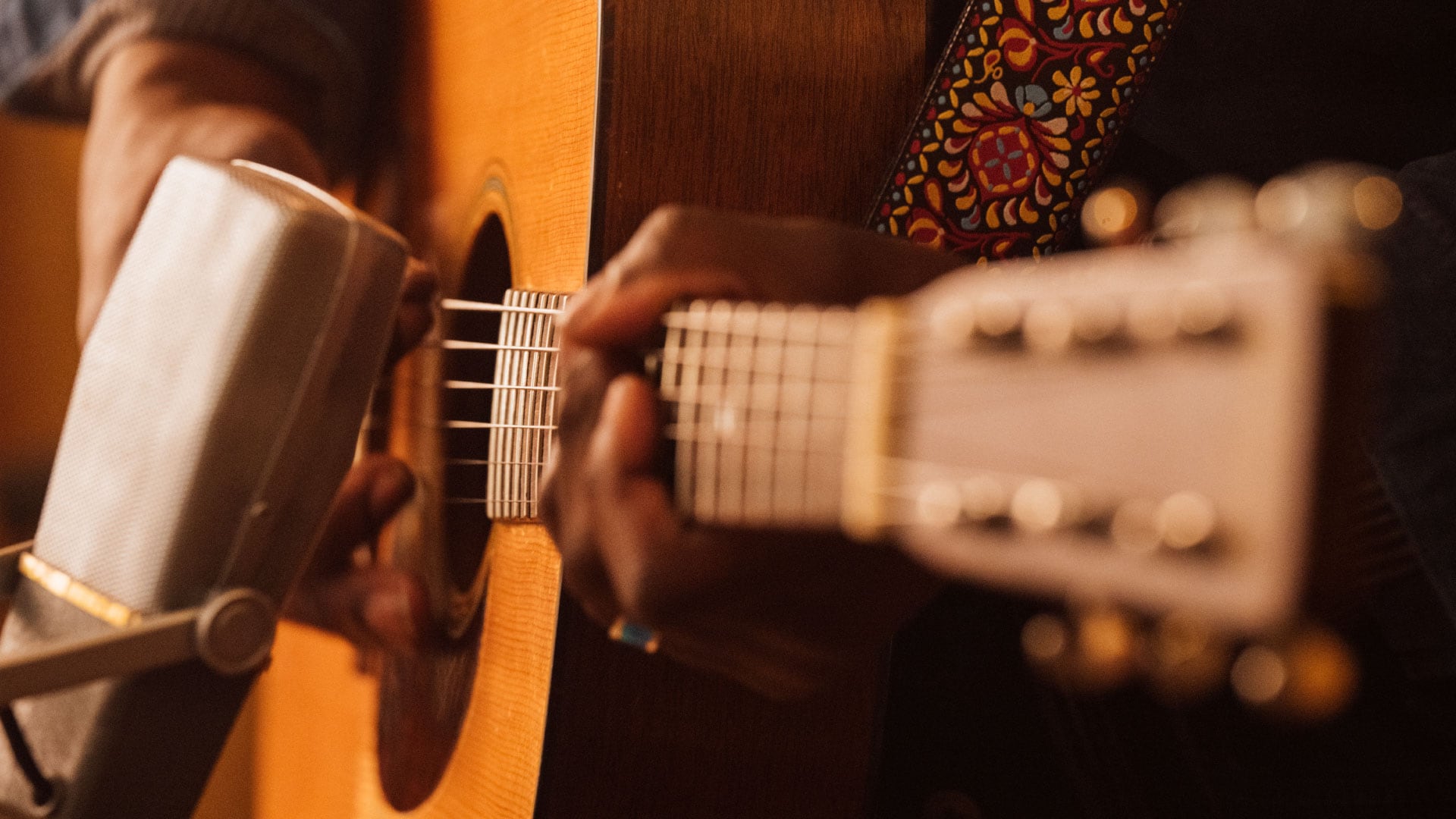
Pictured: Eric's Vintage 1960s Martin 000-18 Acoustic Guitar
Would you mind taking us through a few of your favorite guitars here in the studio?
Burton: This ’60s Martin [000-18] is just a real simple parlor guitar. If I had to choose one instrument in a house to have, it would be this guy. I love the immediacy of its natural organic sound from the steel to the rosewood, and then you have the parlor-sized body. You can take it to a lot of places—it’s so small. I favor a smaller guitar because it gets the job done in a very epic way. I feel like a lot of the tonality also comes from the player, and so for me, individually, me and parlor guitars just go well together. It's probably one of my favorite sounds.
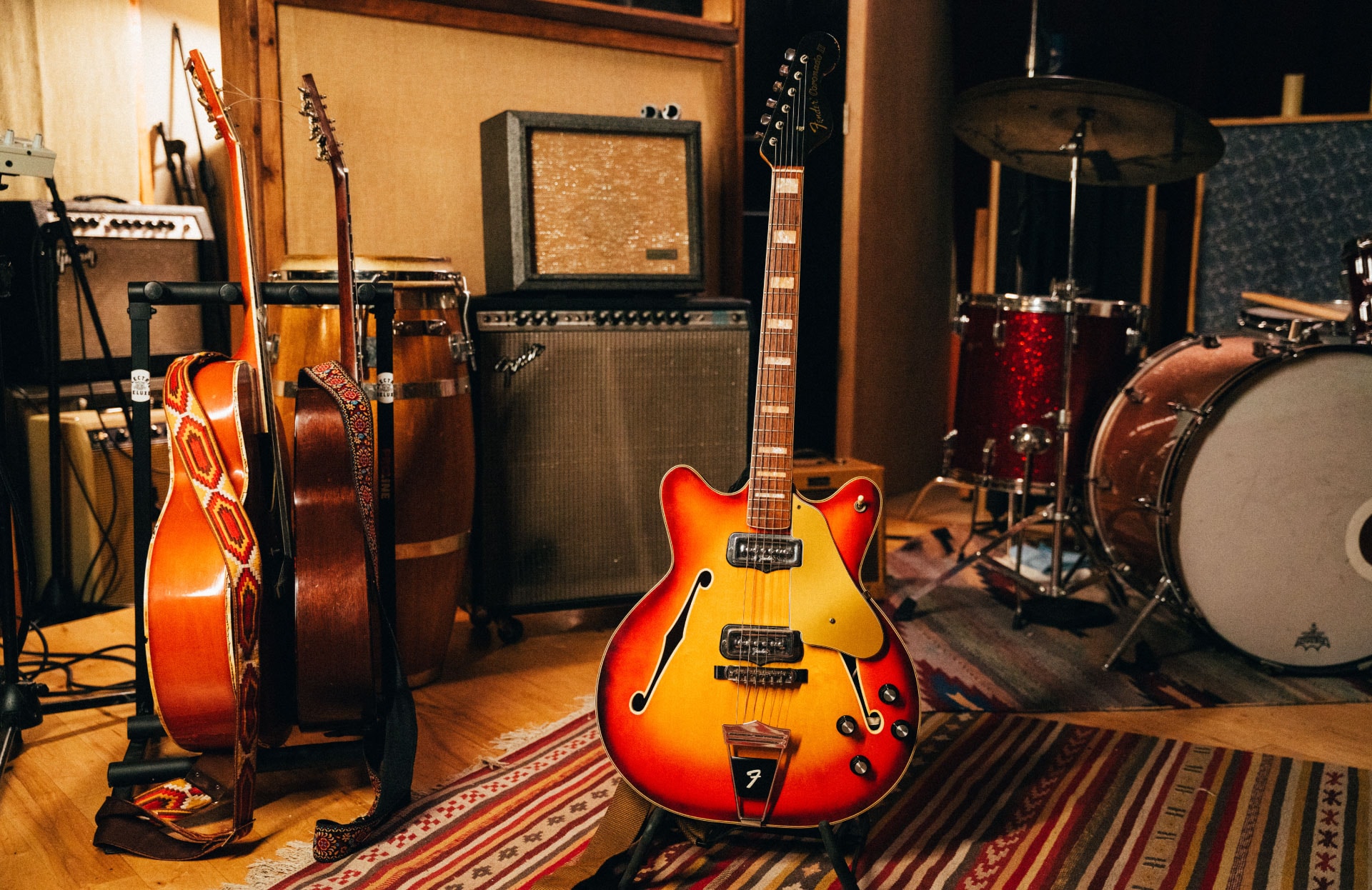
Pictured: Eric's Vintage 1967 Fender Coronado
Burton: This is probably one of my favorite electric guitars—it was a gift from Adrian. It’s my first Coronado. It’s a ’67. It’s got the sunburst. It looks good. I like to play in a very rhythmic way—and for me, a hollowbody feels like it gives that a little bit more power, in an electrified way.
Quesada: I feel that because, before Pumas, you mainly accompanied yourself on acoustic—and now you have to find a guitar that cuts through the band but also still feels like that percussive thing.
Are there any favorite settings or pedals you use with the Coronado?
Burton: When I set the tone for this thing, I really enjoy creamier sounds. I love warm sounds. I like darker tones, for the most part, and this one is just a great bridge between acoustic to electric guitar. With something like this, I don’t get too crazy with the pedals, but I do enjoy a little bit of a boost sometimes. Right now, I’m using a [JHS Pedals] Colour Box. Another effect that I really enjoy using is tremolo and reverb—buckets and buckets of reverb.
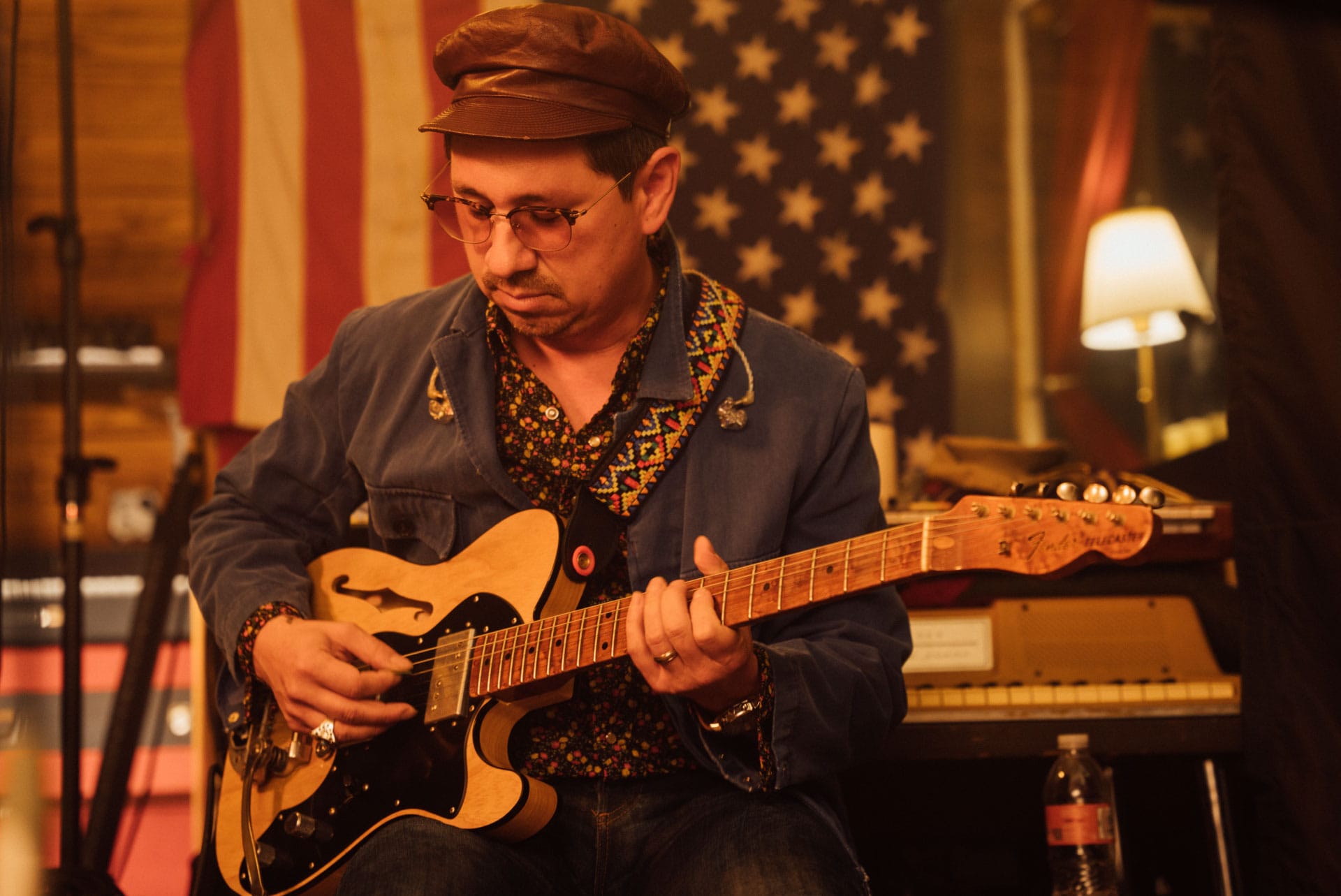
Pictured: Adrian's Fender Custom Shop Telecaster
Quesada: This is the Fender Custom Shop Telecaster that the good people over at Fender made for me. I told them a story about the first Fender Telecaster I bought when I was in college here at UT [University of Texas, Austin]. My guitar was taken away from me, and I went to a store called Ray Hennig’s Heart of Texas music. I took my book money which was $207 and told Ray Hennig my story, and he let me have a Squier Thinline Telecaster for two hundred bucks. He was like, “Just take it, boy.” Before I favored Telecasters, I used to always play guitars with humbucking pickups. When I started to play Fenders—in particular Telecasters—it provided the best of both worlds. It provides more warmth and a little bit more grit and beef, but also that percussive thing that suits the way I play guitar. The Bigsby was not part of the original guitar that I had. There was a while there, particularly on the first Pumas album, where I was just twanging everything. It’s something I like to have as an option—like little sound bombs at the end of songs.
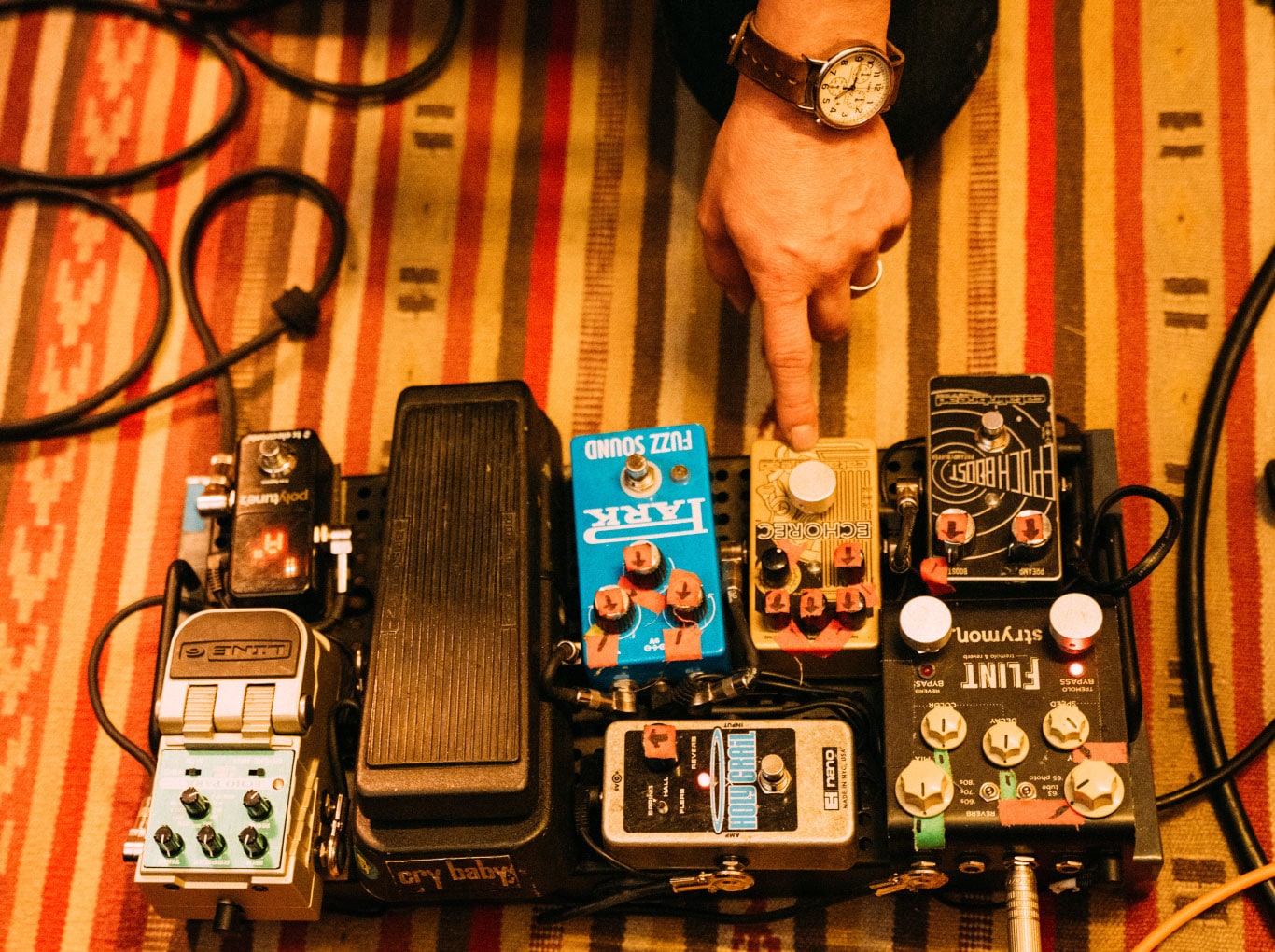
Pictured: Adrian's Pedalboard
Adrian, you create such original guitar tones—can you take us through the tools you use on your pedalboard?
Quesada: Eric is a very rhythmic player as it is, so my typical role with Pumas is that I like to have these tones to kind of complement his—for the two guitars to work together. We both use a lot of reverb and tremolo. This Strymon Flint [pedal]—if I had to lose everything here, this would be the one that gets me through every gig. It’s got tons of reverb options. The tremolo is just incredible, even so much so that, every once in a while, I accidentally change the setting and don’t realize it, and I’m like that’s cool—you can’t go wrong with any of the sounds that come out of this. I use reverb from an amp a lot, but I do like to have more control. I also have an extra spring reverb pedal [Electro-Harmonix Holy Grail Nano]—there are some songs where we just go extra, extra on the spring reverb. So, I like to have these two options. Vintage instruments, by nature, just go out of tune a lot. So, I just need to make sure to always have a tuner [TC Electronic Polytune 2].
I’ve got two delay pedals. The reason for that—the Line 6 Echo Park, which I don’t even think they make anymore—has a tap tempo and, particularly on the song “October 33,” when Eric plays that, I like to be completely dialed into his rhythm. So, while he starts the intro, I have thirty seconds to be tapping the tempo here and lock it in. This Catalinbread Echorec is amazing, based on the Binson Echorec, and this one is my extreme—more of a soundscape-like effects—kind of thing. This boost pedal is a Catalinbread Epoch Boost. It’s a preamp-like boost pedal for certain songs where I just need a little bit more bite and volume.
I used to have a bunch of different fuzz pedals—I’ve gotten down to just this Earthquaker Devices Park Fuzz. It’s just the jam. It really responds to how you play. If I dig in harder and turn on the volume on my guitar, it sounds like a ’60s bonkers fuzz. But if you play it with just a tiny bit less attack, it’s kind of just a distortion pedal.
The wah pedal [Dunlop Original Cry Baby]—I haven’t really been using it a lot lately, but it’s just always been [good] to have one, and when I do get to play wah, it’s super fun. I tried the small wahs. They make those compact ones, and it was just way too awkward. I had to go back to the big one—you need your foot to be able to actually hit it. That’s everything on the pedalboard.
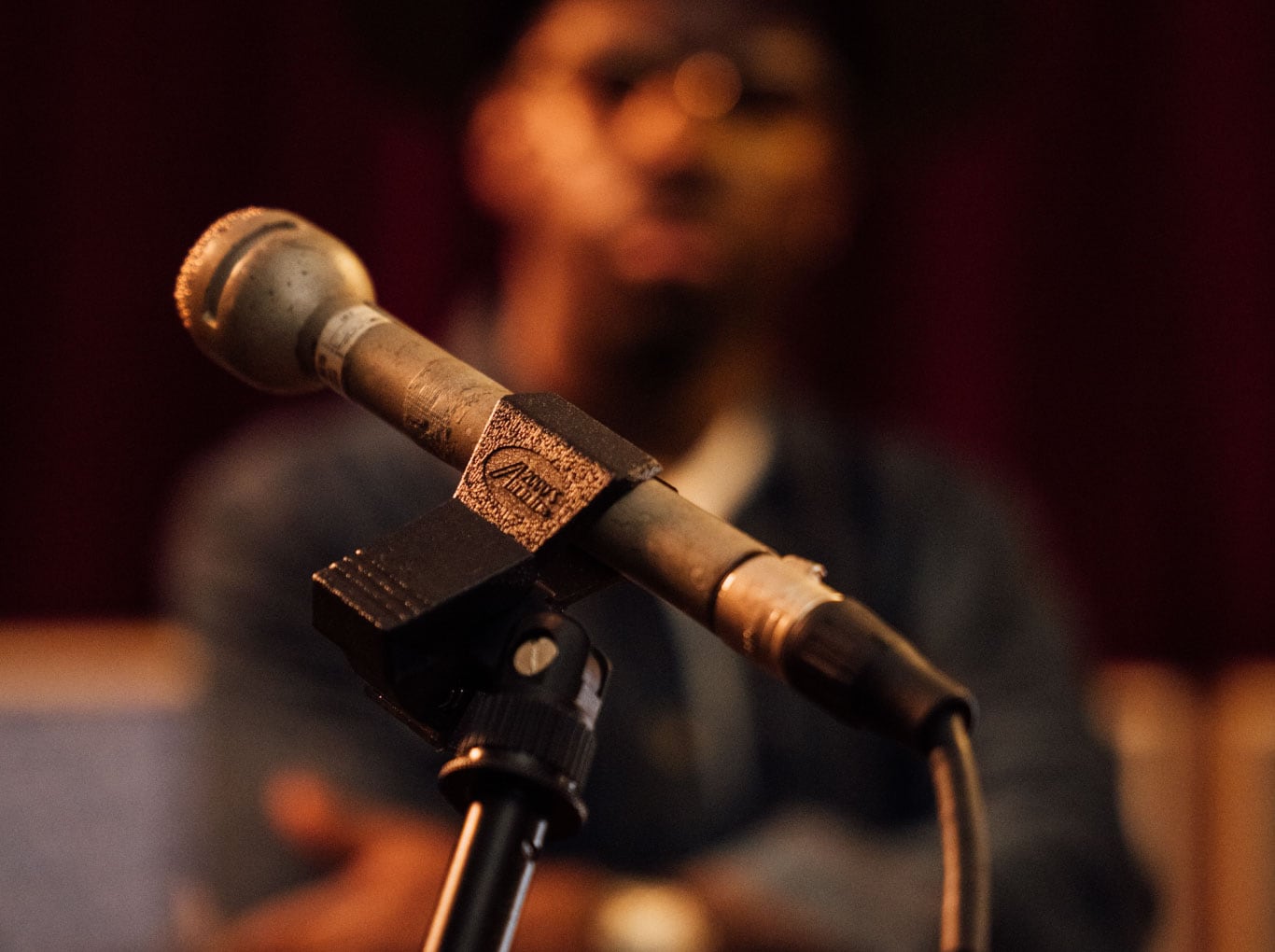
Pictured: Vintage Electro-Voice RE15 Dynamic Microphone
Eric, can you show us a few other pieces of your go-to gear here at Electric Deluxe?
Burton: I think the EV RE15 is super cool. Not just because it’s old, but because it’s also very, very nimble. It feels very unassuming. I feel like I am reflective of an RE15—I might come off as unassuming at face value, but then there’s—there’s big presence, right? My favorite thing about this microphone is that it has a way of rejecting all of the other sound around it, and it really highlights my voice in a way that can allow for distortion depending on what the settings are in the control room.
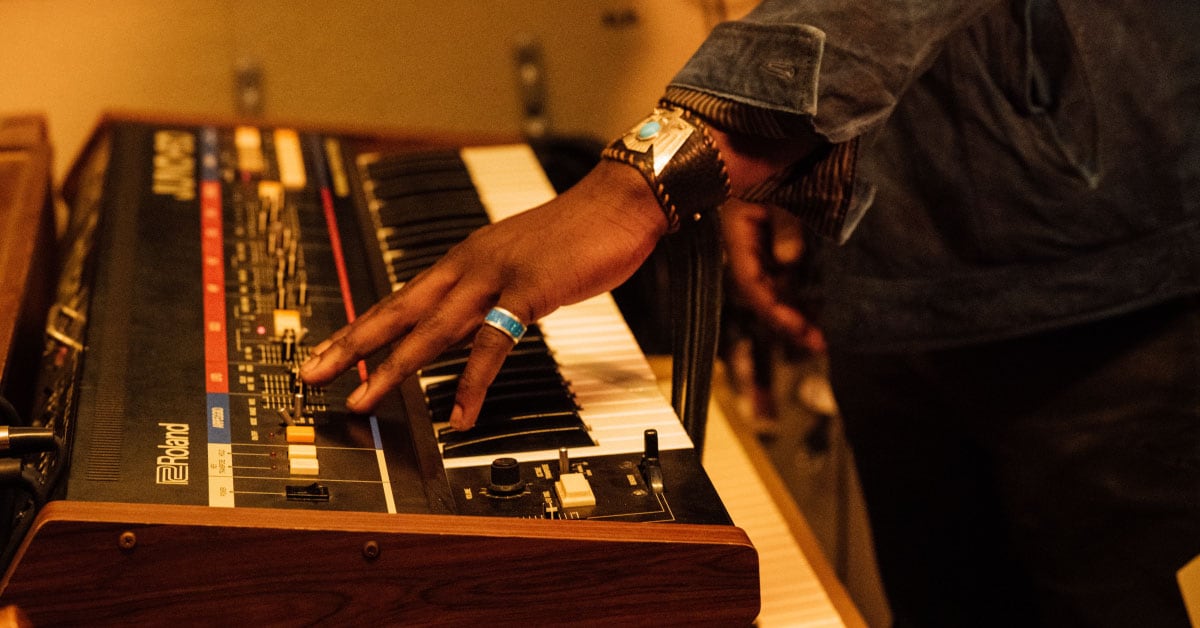
Pictured: Vintage Roland Juno-60 Synthesizer
Burton: The Roland JUNO-60 is one of my favorite keyboards. I started writing some of our new ideas for the second record on one of the minis—a JU-06. It was nice to walk around with the smaller one because it’s battery powered. I think that the ideas are reflective of the fact that I had a lot of fun manipulating some of the waves and writing the new ideas. I really enjoy its spaciness. I mean, we live in Austin, Texas, where people like to keep it weird. For me, it’s the first time that I’d ever used sounds from that perspective to write anything. It’s been a new journey.
Can you speak to how your playing styles complement one another?
Quesada: I love coexisting on guitar with Eric. I’m just a fan of whenever you hear music with two guitars. You know, obvious inspirations—James Brown, the Beatles—they all had two guitars, and I just love the interplay between two guitars in general. But then you add to that, that Eric's style is unique and percussive. It forces me to think. That’s just my favorite thing to do as a guitarist—"How do I complement and fit in here without stepping on any toes," you know? If he’s playing “Touch the Sky” or the lick in the opening riff in “Colors,” the most important thing is to not step on top of that, but add. So, I just love that challenge.
How does the guitar inspire your creativity?
Burton: My favorite thing about the guitar is the immediacy of playing it and the reciprocation from what I’m feeling inside to what the guitar is doing. It’s just a cool thing from one vibration to another. I feel like we’re all vessels of creativity in our most fundamental form, and the guitar serves as a great extension of that for me.
Quesada: Inspiration comes in everything—day-to-day life, love, laughter, happiness and the guitar. I pick it up, and find inspiration in it daily.
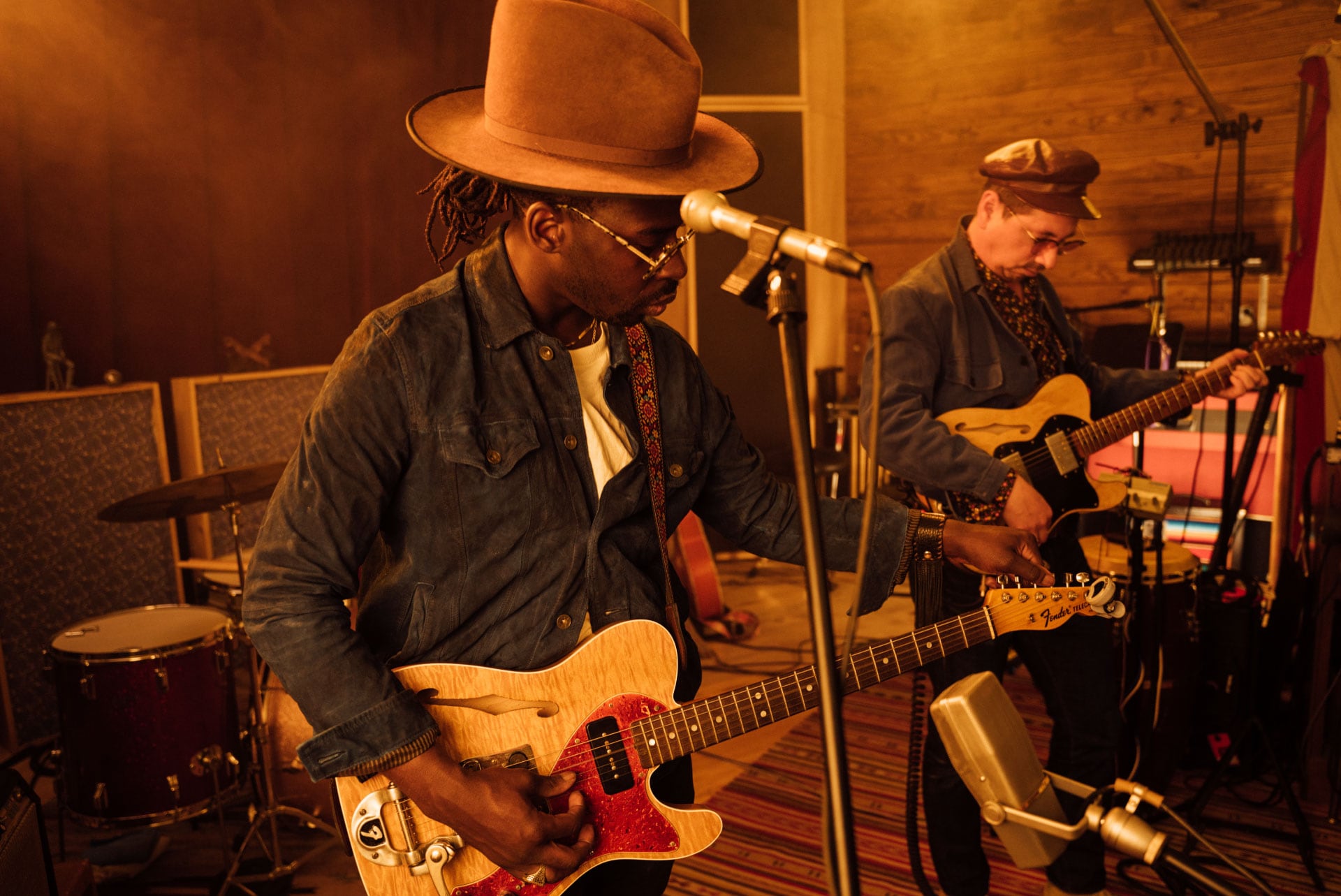
Pictured: Black Pumas at Electric Deluxe Recorders
What do you hope audiences take away from your music?
Burton: I truly hope to break down cultural and social barriers in a venue. I sang in church a bit, and what I walked away with in those situations was the idea that all should be welcome, and all should feel comfortable being vulnerable. For me, I want people to walk away with the fact that they’re worthy of being where they are.
Quesada: On tour in the past, people have proposed to their fiancée onstage. We’ve had people that have come after a funeral and said that they played “Colors” at the wake. I remember this person in Canada who had been harassed for being openly gay, and they told me that our music gets them through. That’s the best we can hope for—and that it puts a smile on people’s faces, too. I hope that our music inspires people to be able to live freely and openly as they wish.
Keep up with Black Pumas.




